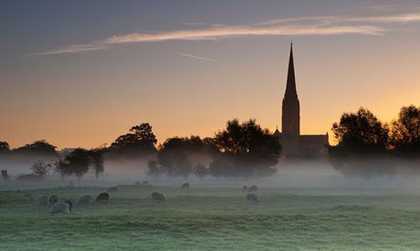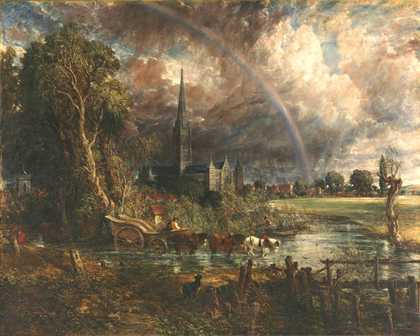
Fig.1
Salisbury Cathedral viewed from Harnham Water in 2013
Source: www.theguardian.com
There are arguably only two church buildings which most citizens of the United Kingdom would immediately recognise from silhouette: St Paul’s Cathedral in the City of London, and Salisbury Cathedral (fig.1), which sits between the counties of Wiltshire and Dorset. Both are buildings that vividly portray visible Christianity and connect with the national consciousness far beyond their roles in the Church of England. It is intriguing to remember that both are known primarily for images created in two very different times of national storm and uncertainty. A black and white photograph of St Paul’s, taken at the end of December 1940 during the Blitz, evokes a foreboding sense of the country at war and the threat to British liberties. In John Constable’s painting Salisbury Cathedral from the Meadows exhibited 1831 (Tate T13896; fig.2), the storm that moves away from Salisbury Cathedral on a summer afternoon and leaves a rainbow, that promise of divine restoration, was developed by the artist at a time when the national establishment of the Church and much else was believed to be at risk of disappearing from the social and political landscape of British society.

Fig.2
John Constable
Salisbury Cathedral from the Meadows exhibited 1831
Tate T13896
Today Salisbury Cathedral is still that symbol of visible Christianity. Its purpose is described as ‘making a difference for God through exceptional worship and outreach’.1 Its doors are permanently open to everyone, be they of sure faith or no religion. You gain a perspective of the cathedral from all points of the compass, whether you follow a route through the chalk downs across Salisbury Plain or approach from the south, perhaps coming off a cruise ship or the Channel ferries. French schoolchildren pass Pepperbox Hill in the ethereal dawn light and view the entire cathedral beckoning them with a distant elegance. It invites you as a work of imagination and extraordinary human endeavour. In a medieval age of widespread illiteracy, a religiously literate community was able confidently to read this building, its architecture and its iconography. Christian believing has also been visible in its liturgy. The Sarum Rite, developed at Salisbury, once set the standard for dignified worship across Western Europe and still the daily habits of worship are part of our spiritual and cultural heritage. It was in Salisbury Cathedral that girls first sang the choral tradition which stretches back over a thousand years of cathedral foundations. The Christianity that is visualised in this space knows how to bring innovation to its traditions and to recognise and celebrate what people call good in their lives. It is true that the cathedral wants people to meet the God whom they see in the face of Jesus Christ, and it knows that such an encounter begins through welcome and hospitality. Yet predominantly what people see when they view Salisbury Cathedral is its beauty.
The compulsion and corruption of beauty
The beauty of Salisbury Cathedral is undisputed. In his 1995 book Notes from a Small Island, the travel writer Bill Bryson stated: ‘There is no doubt in my mind that Salisbury Cathedral is the single most beautiful structure in England and the Close around it the most beautiful space’.2 In 2002 the magazine Country Life ran a competition to find ‘Britain’s Best View’ and the winner was the view of the cathedral across the water meadows, immortalised by Constable and still available to us pretty much as it was in 1831. People often tell me that they prefer other English cathedrals, perhaps Canterbury, Durham or Coventry, but never do they contest the gothic beauty of Salisbury. We can explain some of this. There is a coherence which comes from it having being built in a single period, largely finished within forty years (1220–58), although admittedly its familiar spire and its tower came later (c.1310–30). The geometry offers another explanation: the human eye is captivated by the proportions and the mathematically graceful design. However, the community which has inhabited the place should take some credit for its appearance, because without the continuity of loving stewardship it would not have the same appeal. Since the 1980s the building has been conserved by the skills and artistry of masons and glaziers, in one of only eight Works Departments still left in English cathedrals, producing apprentices in ancient crafts and techniques. In addition, vergers, caretakers and the ‘Holy Dusters’ keep the inside looking loved and fresh, and just about everyone picks up litter or discourages graffiti, while also stepping gently in order to create prayerful instincts. Holy places depend on everyday saints to preserve the quality of beauty.
Yet beauty is not just about taste or aesthetic appeal. It acts like an angel, a messenger from God, drawing us into things beyond the material and immediate. Beauty has the ability to move our inner being, our soul in the direction of eternity, heightening the appreciation of things which will endure in our life. It is often in the experience of beauty that we find meaning, even in the face of our sorrow and suffering. Beauty is never about perfection: we can find beauty in the idiosyncrasies of a loved one’s face. Beauty is not unchanging. The grace of Salisbury Cathedral changes constantly, at different times of day, between seasons and, as Constable reminded us in Salisbury Cathedral from the Meadows, with the weather.
If beauty is an angel inviting us to sense the presence of God in our life then it is also a dark angel, capable of corruption. Beauty offers us notions of false safety and self-satisfaction. It is able to lead us into falsehood. As is expressed in this prayer by Hugh Dickinson, one of my predecessors as Dean of Salisbury (1986–96), beauty is often only redeemed by living alongside the challenges of pain and loss:
God of light and darkness, God of pain and beauty,
as we kneel in this beautiful and holy place
keep always in our minds a sense of the pains and griefs
with which so many millions of people live and die
only just over the horizon of our world.
In Jesus you have shown us
that without the pain the beauty has no heart,
and that without the beauty the world’s pain has no hope.
Teach us, Lord, how to hold on to the beauty and pain of your world
as you have done in the Cross and Resurrection of your Son,
Jesus Christ our Lord.3
England’s green and pleasant land
One of Constable’s contemporaries, the artist and poet William Blake, gave us contrasting archetypes for our sense of nationhood in the words of his c.1808 poem ‘And Did Those Feet in Ancient Time’, which many of us know as the hymn ‘Jerusalem’.4 Recognising that there are ‘dark, satanic mills’, Blake parallels that reality with the language of ‘England’s pleasant pastures’, ‘England’s mountains green’ and finally the crescendo of ‘England’s green and pleasant land’ – images conjured by Constable in Salisbury Cathedral from the Meadows. These are powerful expressions of something we believe to be quintessentially of English land. Englishness can be rooted in a sentimental view of nature, a pastoral idyll, a bucolic quietude. Despite the storm clouds it is a magnificent building set within a rural landscape which is so defining in this particular contribution to Constable’s legacy. Constable and his friend Archdeacon Fisher may have worried about the world as contested space and the future impact of political and social turmoil. Yet in Salisbury Cathedral from the Meadows the artist leaves us with the terror and majesty of the living God set within a natural world at ease with itself and God’s covenantal promise that his purposes would be forever benevolent.
Again, there is more to the cathedral’s identity than simply the picturesque and pastoral. The appeal of such has to sit alongside other realities of English life if it is not to distort our consciousness. Our default identity needs more than romanticism if it is to produce a sense of strong citizenship. The Church must offer better traditions and lived religion rather than indulging in concepts of purity or idealism.
We do well to recall that Salisbury Cathedral is also the home to Magna Carta. As custodian since 1215 of the best surviving copy of that iconic document we are encouraged not to fall into an abandonment of the will or neglect of the greater good when faced with contested matters. Englishness is not a matter of ethnicity or images of a rural homeland but it has been about building a society in this national context around the rule of law. It is about shaping life in these islands around shared values of freedom, liberty and tolerance, themselves constructed on the foundation of justice for all. Such things have grown out of a Christian anthropology believing that all of human being is made in the image of God. In turn this has asked of us a profound commitment to the dignity and equality of all.
Religious identity
We might also remember that the religious identity of Constable’s friends in Salisbury will have been significantly influenced by the fact that two hundred years earlier Salisbury Cathedral had been the spiritual home of two giants, intellectual and literary, of Anglican identity. Richard Hooker was Subdean of the cathedral while holding the living of Boscomb in Wiltshire and engaged in writing the defining work of Church of England ecclesiology, Of the Laws of Ecclesiastical Politie (1594–7). Thirty years later the poet-priest George Herbert, while Rector of Bemerton, used to walk across the same water meadows twice each week to Cathedral Evensong, his desire being, according to his biographer Izaac Walton, ‘to enjoy his heaven upon earth’.5
This was a developing Anglicanism that was defined for these men not so much by its place in the political establishment but by its cultural habits, the way it was planted in the soil of the parish and pastoral realities of local life, and its openness to changing social and scientific thought. It was not a fundamentalist religion and has ever resisted being so. Nor was it a quietist religion, for although there were mystical elements there was also a distinctive core of social action borne of pastoral zeal. It was a religion able to cope with ambiguity and paradox, and quietly merciful about human failings. Cathedrals have always held to that style and flavour of Anglicanism which resisted turbulent and toxic religion, standing over and against zealous rigidities not with a response of conservatism but with the resources of hospitality (‘Love bade me welcome’, in Herbert’s poetic words),6 with the power of learning and the daily habits of understated and dignified liturgy, perfectly displayed in the Evening Collect:
Lighten our darkness, we beseech thee, O Lord; and by thy great mercy defend us from all perils and dangers of this night; for the love of thy only Son, our Saviour Jesus Christ.
For in the end, the Church down the ages – Salisbury Cathedral included – has been less under threat from external forces and social or political trends than from its own inability to live true to itself as a religion that is outward-facing and compassionate, and which offers prayer as ‘Softness, and peace, and joy, and love, and bliss … Heaven in ordinary … something understood’.7
